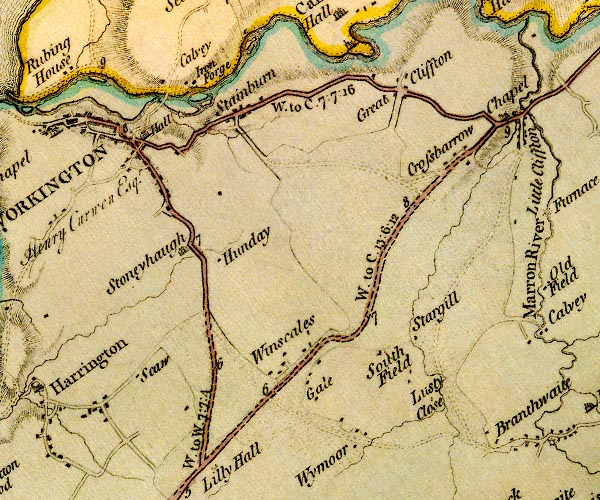




placename:- Beerpot Ironworks
"Beerpot Ironworks"

D4NY02NW.jpg
"Iron Forge"
blocks, building/s; and circle with rays, mill wheel; a water mill
item:- Carlisle Library : Map 2
Image © Carlisle Library
 Old Cumbria Gazetteer
Old Cumbria Gazetteer |
 |
   |
| Beerpot Ironworks, Workington | ||
| gone | ||
| Beerpot Ironworks | ||
| Bearpot Ironworks | ||
| Barepot Ironworks | ||
| Seaton Ironworks | ||
| locality:- | Barepot | |
| locality:- | Workington | |
| civil parish:- | Workington (formerly Cumberland) | |
| county:- | Cumbria | |
| locality type:- | ironworks | |
| locality type:- | blast furnace | |
| coordinates:- | NY01262940 (about) | |
| 1Km square:- | NY0129 | |
| 10Km square:- | NY02 | |
| references:- | OS County Series |
|
|
|
||
| evidence:- | old map:- OS County Series (Cmd 53 7) placename:- Beerpot Ironworks |
|
| source data:- | Maps, County Series maps of Great Britain, scales 6 and 25
inches to 1 mile, published by the Ordnance Survey, Southampton,
Hampshire, from about 1863 to 1948. "Beerpot Ironworks" |
|
|
|
||
| evidence:- | old map:- Donald 1774 (Cmd) |
|
| source data:- | Map, hand coloured engraving, 3x2 sheets, The County of Cumberland, scale about 1
inch to 1 mile, by Thomas Donald, engraved and published by Joseph Hodskinson, 29
Arundel Street, Strand, London, 1774. D4NY02NW.jpg "Iron Forge" blocks, building/s; and circle with rays, mill wheel; a water mill item:- Carlisle Library : Map 2 Image © Carlisle Library |
|
|
|
||
| :- |
Bearpot Ironworks, furnace and foundry, established about 1762. |
|
| Marshall, J D &Davies-Shiel, Michael: 1977 (2nd edn): Industrial Archaeology of the
Lake Counties: Moon, Michael (Beckermet, Cumbria):: ISBN 0 904131 13 0 |
||
|
|
||
| notes:- |
Founded 1762, built 1763. James Spedding was a key figure in the development, the
company was called Spedding, Hicks and Co. The ore was kidney iron ore, haematite.
At first, the blast furnace was fueled by charcoal, brought from Scotland; the blowing
was water powered. |
|
| Closed 1899. |
||
| Lancaster and Wattleworth 1977 |
||
|
|
||
| notes:- |
Hutchinson's History of Cumberland:- |
|
| "Between Workington and Seaton, on the banks of the Derwent are considerable ironworks,
called Seaton Ironworks, planned and built under the direction of that eminent engineer
Thomas (sic) Spedding Esq., of Whitehaven in 1763. They have two blast furnaces for
the smelting of iron ore, a mill for slitting and rolling of bar iron, a double forge
for refining and drawing of bar iron, a foundry with several small furnaces, wherein
they make cannon and cast iron work of all sorts; a boring mill for boring cannon
cylinders, etc., a grinding house and turning house and many other conveniences suitable
for carrying on very extensive iron manufacturing. The whole gives bread to several
hundred of the industrious and laborious part of mankind. These works are carried
on under thye firm of Spedding, Hicks &Co" |
||
| Hutchinson:: History of Cumberland |
||
|
|
||
 Lakes Guides menu.
Lakes Guides menu.